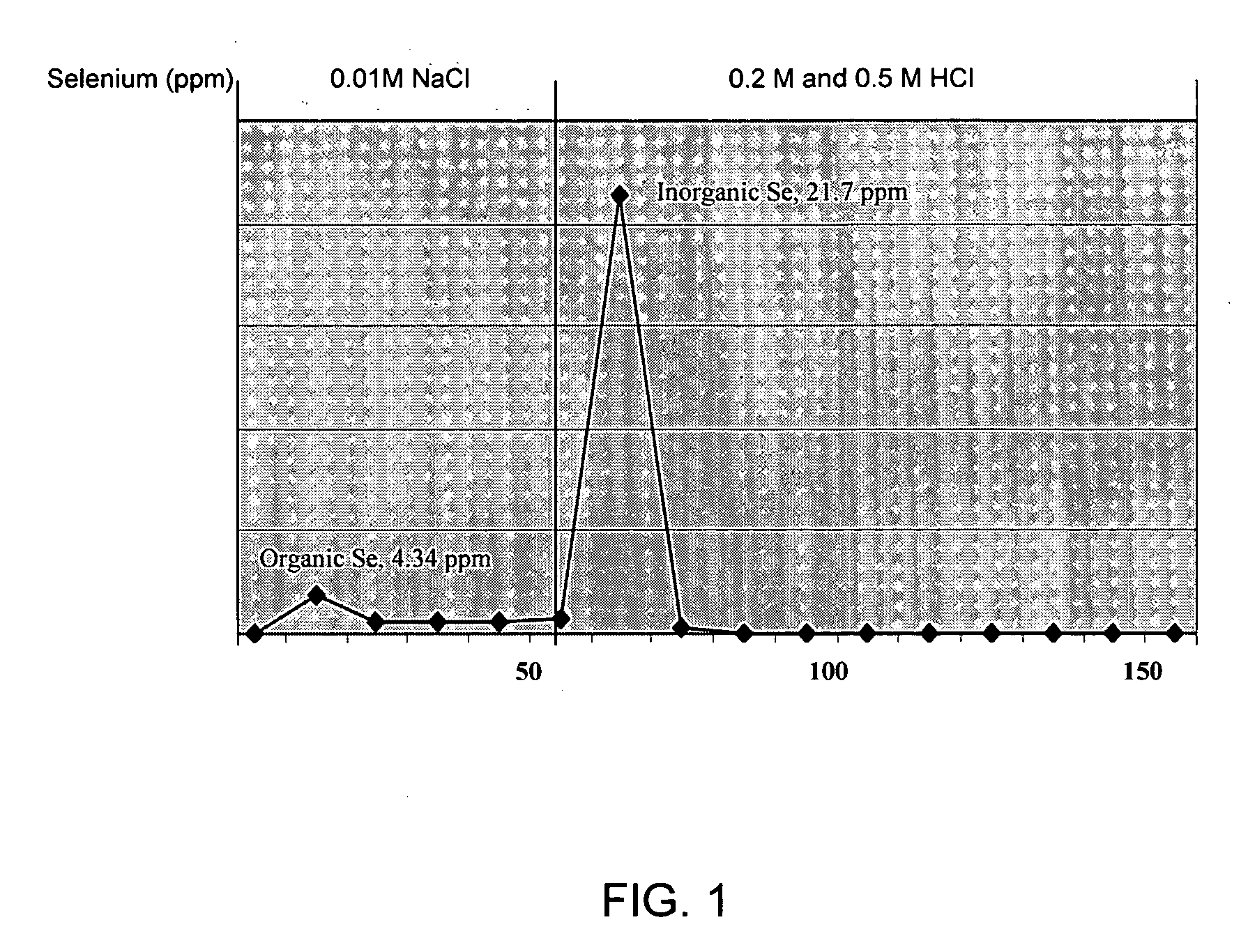Production of organic and inorganic selenium compounds by lactic acid bacteria
a technology of organic and inorganic selenium compounds and bacteria, which is applied in the direction of bacteria material medical ingredients, bacteria based processes, biocide, etc., can solve the problems of reduced growth rate and even death, toxic to biological systems at the level of parts per million (ppm), and poultry may develop exudative diathesis, etc., to achieve enhanced glutathione peroxidase activity, improve feed conversion rate, and increase the absorption and retention of selenium
- Summary
- Abstract
- Description
- Claims
- Application Information
AI Technical Summary
Benefits of technology
Problems solved by technology
Method used
Image
Examples
example 1
Isolation and Identification of Lactic Acid Bacteria from the GI Tract of Chickens
Materials and Methods
[0017] Gastrointestinal tracts from three healthy chickens were obtained from a local market certified by the Agri-Food & Veterinary Authority of Singapore. Sections comprising the duodenum, jejunum and ileum of each intestinal tract were macerated and their contents were inoculated into de Man Rogosa Sharpe broth pH 6.3 (MRS) (Becton, Dickinson, USA) and incubated in an incubator set at 30° C. under 5% CO2 for 24 h. Overnight cultures were streaked for isolation of pure colonies on MRS agar, pH 6.3 before sub-culturing in MRS broth using the same conditions and kept in 40% glycerol at −80° C. for long-term storage. Gram staining and biochemical tests (API® 50 CH test kit; bioMerieux, USA) were performed to identify the strains of lactic acid bacteria isolated from the gastrointestinal tract of healthy chickens.
Results
[0018] A total of 120 strains of microaerophilic and anaer...
example 2
Identification of Lactic Acid Bacteria (LAB) Strain SP80
Materials and Methods
[0019] A strain of LAB, identified herein as SP80 was selected out of the 97 strains previously isolated and screened for growth in media containing sodium selenite (25, 50, 100 and 200 ppm). The bacterium was selected based on the growth rate and ability of the cells to convert sodium selenite to amorphous selenium, indicated by the formation of red-pigmented colonies.
[0020] SP80 was grown in MRS broth at 30° C. under 5% CO2 for 24 h. Five-ml portions of the culture were centrifuged at 5700×g for 10 min and the supernatant discarded. The pellet was then resuspended in CHL media (bioMérieux, USA) before dispensing into the cupules of the API® 50 CH test strips. The strips were incubated at 37° C. for 48 h. After 48 h, the results of the biochemical tests were analyzed using the automated identification software, API® LAB Plus™ (bioMérieux, USA). This strain was also found to be heat resistant at 60° C. ...
example 3
Uptake of Selenium by Pediococcus Pentosaceus SP80
Materials and Methods
[0022] Culture of Pediococcus pentosaceus SP80 on media containing sodium selenate and selenite. Pediococcus pentosaceus SP80 obtained from −80° C. freezer was resuscitated and grown in MRS broth at 30° C. under 5% CO2 for 24 h. The cells were then inoculated into sulfur-limiting media (SLM; pH 6.0) containing 40 g / L of buffered peptone water (BPW; pH 7.4), 32 g / L Lab-Lemco powder, 16 g / L yeast extract (Oxoid, UK), 80 g / L glucose, 20 g / L sodium acetate trihydrant, 8 g / L di-potassium hydrogen phosphate anhydrous, 0.8 g / L magnesium chloride, 0.2 g / L manganese (II) chloride (Merck, Germany), 8 g / L citric acid and 4 g / L Tween® 80. The medium was then supplemented with sodium selenate (0, 250 ppm) or selenite (0, 1, 10, 50, 100, 250, 500 and 1000 ppm) (Sigma Chemicals, USA). The cultures were incubated at 30° C. under 5 % CO2 for 24 h. Serial dilutions and plate count were performed using BPW and MRS agar, respecti...
PUM
| Property | Measurement | Unit |
|---|---|---|
| pH | aaaaa | aaaaa |
| height | aaaaa | aaaaa |
| lactic acid | aaaaa | aaaaa |
Abstract
Description
Claims
Application Information
 Login to View More
Login to View More - R&D
- Intellectual Property
- Life Sciences
- Materials
- Tech Scout
- Unparalleled Data Quality
- Higher Quality Content
- 60% Fewer Hallucinations
Browse by: Latest US Patents, China's latest patents, Technical Efficacy Thesaurus, Application Domain, Technology Topic, Popular Technical Reports.
© 2025 PatSnap. All rights reserved.Legal|Privacy policy|Modern Slavery Act Transparency Statement|Sitemap|About US| Contact US: help@patsnap.com

